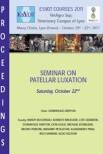OBJECTIVE: To compare the geometrical properties and bone mineral density (BMD) of the proximal radius between Saint Bernard and other giant breed dogs.
STUDY DESIGN: Observational, cross-sectional, descriptive study.
ANIMALS: Thirteen client-owned Saint Bernard dogs and 13 other client-owned giant breed dogs.
METHODS: Computed tomography (CT) studies of Saint Bernard and other giant breed dogs were reviewed. Multiplanar reconstruction of the CT images was used to determine cross-sectional variables at the proximal half of the radius, including mean cortical thickness (mCT) and moment of inertia (MOI). Cortical BMD was estimated from Hounsfield unit measurements at each cross-section and averaged per bone. One-way analysis of variance was used to detect differences between groups.
RESULTS: Proximal radii of Saint Bernard dogs had a lower cortical/medullary ratio (1.75 vs 2.2, P < .001), mCT (1.96 vs 2.64 mm, P < .001), and MOI in all planes (mediolateral [ML]: 2086.09 vs 2757.69 mm4 , P < .001; craniocaudal [CrCd]: 3736.36 vs 4370.28 mm4 , P = .025; and polar: 5852.45 vs 7127.97 mm4 , P = .002) compared with bones of other breeds. Cross-sectional BMD did not differ between groups of dogs, but the mean BMD of all cross-sections was lower in Saint Bernard dogs (1214.27 vs 1289.80 mg/mm3 , P = .029).
CONCLUSION: The proximal radii of Saint Bernard dogs had thinner cortices and lower CrCd, ML, and polar MOI compared with corresponding bones in giant breed dogs.
CLINICAL SIGNIFICANCE: The structural properties of the proximal radius of the Saint Bernard differ from those in other giant breeds and could reduce the ability of this region to sustain biomechanical loads. These properties could predispose Saint Bernard dogs to complications after surgical limb-sparing procedures.









